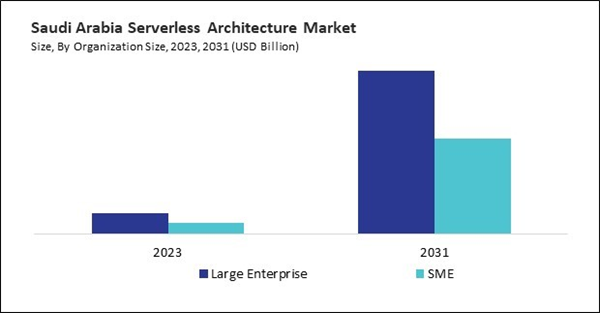The Brazil market dominated the LAMEA Serverless Architecture Market by country in 2023, and is expected to continue to be a dominant market till 2031; thereby, achieving a market value of $1.17 billion by 2031. The Argentina market is showcasing a CAGR of 31.3% during 2024-2031. Additionally, the UAE market would register a CAGR of 28.2% during 2024-2031.
Serverless computing abstracts away the need to manage the underlying infrastructure, allowing developers to focus on writing code and delivering functionality. As a result, organizations can reduce the time spent on provisioning and managing servers, improving productivity. Furthermore, serverless platforms automatically handle tasks such as patching, scaling, and monitoring, minimizing the operational burden on IT teams.
Moreover, this architecture promotes a more agile development environment. Developers can write small units of code (functions) that can be deployed independently, tested more easily, and iterated rapidly. This decoupled architecture allows for quicker releases of new features and enhancements. The lack of infrastructure management responsibilities lets developers focus entirely on application logic and user experience.
The UAE is part of the MENA region, which is witnessing substantial growth in the entertainment streaming industry, projected to expand from USD 4.7 billion to USD 5.6 billion by 2021. As the region experiences such rapid growth, this architecture offers an ideal solution for entertainment streaming platforms. Scaling resources based on demand without extensive infrastructure management is essential for streaming platforms handling fluctuating traffic volumes. Saudi Arabia’s significant healthcare expenditure - projected at $50.4 billion in 2023 - presents a massive opportunity for digital transformation within the sector. As the government continues prioritizing healthcare, the demand for innovative solutions will grow to streamline operations, improve patient care, and optimize resources. This architecture can support these advancements by providing scalable, cost-effective infrastructure for healthcare applications, from patient management systems to telemedicine platforms. Thus, the growth of the entertainment streaming industry in the UAE and the increasing healthcare expenditures in Saudi Arabia are driving the need for scalable, technological solutions.
List of Key Companies Profiled
- Amazon Web Services, Inc. (Amazon.com, Inc.)
- Cisco Systems, Inc.
- Datadog, Inc.
- Google LLC (Alphabet Inc.)
- IBM Corporation
- Microsoft Corporation
- Oracle Corporation
- Dynatrace, Inc.
- TIBCO Software, Inc. (Vista Equity Partners Management, LLC)
- NTT Data Corporation
- Alibaba Cloud (Alibaba Group Holding Limited)
- Cloudflare, Inc.
- Vercel Inc.
Market Report Segmentation
By Organization Size- Large Enterprise
- SME
- Public Cloud
- Private Cloud
- Hybrid Cloud
- Automation & Integration
- API Management
- Monitoring
- Security
- Support & Maintenance
- Training & Consulting
- Other Services
- BFSI
- Retail & Ecommerce
- Media & Entertainment
- Telecom & IT
- Government & Public
- Healthcare & Life Sciences
- Manufacturing
- Other Vertical
- Brazil
- Argentina
- UAE
- Saudi Arabia
- South Africa
- Nigeria
- Rest of LAMEA
Table of Contents
Companies Mentioned
- Amazon Web Services, Inc. (Amazon.com, Inc.)
- Cisco Systems, Inc.
- Datadog, Inc.
- Google LLC (Alphabet Inc.)
- IBM Corporation
- Microsoft Corporation
- Oracle Corporation
- Dynatrace, Inc.
- TIBCO Software, Inc. (Vista Equity Partners Management, LLC)
- NTT Data Corporation
- Alibaba Cloud (Alibaba Group Holding Limited)
- Cloudflare, Inc.
- Vercel Inc.
Methodology

LOADING...









